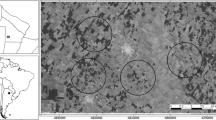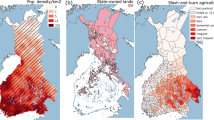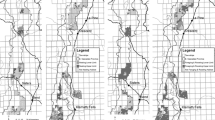Abstract
Populations of the internationally protected Black Stork Ciconia nigra in the northern parts of the distribution range, located to the east of the Baltic Sea, have suffered decline over recent decades. Since early 1990s, however, logging intensity has increased. In this paper, considering a ten-year period from the mid-1990s, we ask: (a) Did changes occur in the habitat preferred by Black Stork in the decade? (b) did the decade of intensified forestry significantly change forest characteristics? and (c) could the intensified forestry explain any observed changes in the utilization of habitat by storks? We compared forest characteristics at the beginning and end of this period at 75 random points and compared the habitat at 75 nest sites occupied by the Black Stork in the mid-1990s and 75 occupied nest sites at the end of the 2000s. In the 0.7-km zones around the random points, the abundance of mature stands decreased between the mid-1990s and the end of the 2000s, as did the abundance of broadleaved trees, but black alders increased. Nevertheless, the age and composition of tree species within the stands around the random points remained similar. Some changes were noted though in the habitat around nests used by Black Storks during two periods, with the data indicating that the Black Storks tended to occupy sites of better habitat quality (e.g. with a higher density of hydrological network and old oak trees, older nest stands) at the end of the 2000s than in the mid-1990s. Our results, however, do not support the idea that intensified forestry over the short term induced changes in the habitat used by the Black Storks. It is possible that nesting Black Storks became concentrated into the prime habitat when population retracted and/or abandoned habitat where recently recovered by the White-tailed Eagle.


Similar content being viewed by others
References
Andersson L, Kriukelis R, Skuja S (2005) Woodland key habitat inventory in Lithuania. Lithuanian Forest Inventory and Management Institute and Regional Forestry Board of Östra Götalan, Vilnius
Angelstam P, Roberge JM, Lõhmus A, Bergmanis M, Brazaitis G, Dönz-Breuss M, Edenius L, Kosinski Z, Kurlavičius P, Lārmanis V, Lūkins M, Mikusiński G, Račinskis E, Strazds M, Tryjanowski P (2004) Habitat modelling as a tool for landscape-scale conservation—a review of parameters for focal forest birds. Ecol Bull 51:427–453. doi:10.2307/20113327
Anonymous (2002) Comprehensive plan of the territory of the Republic of Lithuania. http://gis.am.lt/bp
Block WM, Brennan LA (1993) The habitat concept in ornithology. Theory and applications. In: Power DM (ed) Current ornithology 11. Plenum Press, New York, pp 35–91
Brown JL (1969) Territorial behavior and population regulation in birds. Wilson Bul 81:293–329
Brukas V (2015) New world, old ideas—A narrative of the Lithuanian forestry transition. J Environ Policy Plan 17:495–515. doi:10.1080/1523908X.2014.993023
Brukas V, Felton A, Lindbladh M, Sallnäs O (2013) Linking forest management, policy and biodiversity indicators—A comparison of Lithuania and Southern Sweden. Forest Ecol Manag 291:181–189. doi:10.1016/j.foreco.2012.11.034
Brukas V, Stanislovaitis A, Kavaliauskas M, Gaizutis A (2016) Protecting or destructing? Local perceptions of environmental consideration in Lithuanian forestry. Land Use Policy (Accepted)
Burnham KP, Anderson DR (2002) Model selection and multimodel inference: a practical information-theoretic approach, 2nd edn. Springer, New York
Butchart SHM, Walpole M, Collen B, van Strien A, Scharlemann JPW, Almond RE et al (2010) Global biodiversity: indicators of recent declines. Science 328:1164–1168. doi:10.1126/science.1187512
CBD (Convention on Biological Diversity) (2010) The strategic plan for biodiversity 2011–2020 and the Aichi biodiversity targets. Convention on biological diversity, UNEP/CBD/COP/DEC/X/2
CORINE Land Cover (1995). https://www.geoportal.lt/metadata-catalog/catalog/search/resource/details.page?uuid={61E0EB1E−0CA0-81AA-578F-F3DD7ACC0D5A}
Drobelis E (1993) On the biology and protection of Black Stork (Ciconia nigra L.) in Lithuania. Acta ornithol Lituan 7–8:94–99
Drobelis E, Matiukas G, Vaitkus G (1996) Juodųjų gandrų apskaita Lietuvoje 1995 metais [Results of the Lithuanian Black Stork census in 1995]. Ciconia 4:16–21 [in Lithuanian with English summary]
Elbakidze M, Ražauskaitė R, Manton M, Angelstam P, Mozgeris G, Brūmelis G, Brazaitis G, Vogt P (2016) The role of forest certification for biodiversity conservation: Lithuania as a case study. Eur J For Res. doi:10.1007/s10342-016-0940-4
Gamauf A, Tebb G, Nemeth E (2013) Honey Buzzard Pernis apivorus nest-site selection in relation to habitat and the distribution of the Goshawks Accipiter gentilis. Ibis 155:258–270. doi:10.1111/ibi.12023
Hakkarainen H, Mykrä S, Kurki S, Tornberg R, Jungell S (2004) Competitive interactions among raptors in boreal forests. Oecologia 141:420–424. doi:10.1007/s00442-004-1656-6
Jones J (2001) Habitat selection studies in avian ecology: a critical review. Auk 118:557–562. doi:10.1642/0004-8038(2001)118[0557:HSSIAE]2.0.CO;2
Juknelienė D, Mozgeris G (2015) The spatial pattern of forest cover changes in Lithuania during the second half of the twentieth century. Žemės ūkio mokslai [Agricultural Sciences] 22(4):209–215. doi:10.6001/zemesukiomokslai.v22i4.3215
Katzner TE, Bragin EA, Knick ST, Smith AT (2003) Coexistence in a multispecies assemblage of eagles in central Asia. Condor 105:538–551. doi:10.1650/7140
Kuliešis A (1993) Lietuvos medynų prieaugio panaudojimo normatyvai [Forest yield models and tables in Lithuania].Girios Aidas, Kaunas (in Lithuanian)
Kuliešis A, Kenstavičius J, Grigaliūnas J, Garbinčius A (1983) Lietuvos pagrindinių medžių rūšių stiebų formrodžių priklausomybės nuo skersmens ir aukščio matematinių modelių parametrai [Parameters of mathematic models describing the dependence of stem form on the tree diameter and height for major Lithuanian tree species]. In: Miško taksuotojo žinynas [Manual of forest scaler]. Mokslas, Vilnius, p 34 (In Lithuanian)
Lämås T, Sandström E, Jonzén J, Olsson H, Gustafsson L (2015) Tree retention practices in boreal forests: What kind of future landscapes are we creating? Scand J For Res 30:526–537. doi:10.1080/02827581.2015.1028435
Lõhmus A (2001) Habitat selection in a recovering osprey Pandion haliaetus population. Ibis 143:651–657. doi:10.1111/j.1474-919X.2001.tb04893.x
Lõhmus A (2003) Do Ural Owls (Strix uralensis) suffer from the lack of nest sites in managed forests? Biol Conserv 110:1–9. doi:10.1016/S0006-3207(02)00167-2
Lõhmus A (2006) Nest-tree and nest-stand characteristics of forest-dwelling raptors in east-central Estonia: implications for forest management and conservation. Proc Estonian Acad Sci Biol Ecol 55:31–50
Lõhmus A, Sellis U (2003) Nest trees—a limiting factor for the black stork population in Estonia. Aves 40:84–91
Lõhmus A, Sellis U, Rosenvald R (2005) Have recent changes in forest structure reduced the Estonian black stork Ciconia nigra population? Biodivers Conserv 14:1421–1432. doi:10.1007/s10531-004-9667-5
Ministry of Environment (2015) Forest Cutting Rules. Came into force on 27th Jan 2010, last amendment on 30th Sep 2015, Vilnius. https://www.e-tar.lt/portal/lt/legalAct/9903de00674511e58e1ab2c84776483b. Accessed 18 Sep 2015
Mozgeris G, Galaunė A, Palicinas M (2008) Systemy informacji geograficznej w urządzaniu lasu na Litwie—dekada praktycznego stosowania [Geographic information systems in Lithuanian forest management planning—A decade of operational application]. Sylwan 152:58–63 (in Polish)
Mozgeris G, Stanislovaitis A, Brukas V, Kavaliauskas M, Palicinas M (2016) Owner mapping for forest scenario modelling—A Lithuanian case study. For Policy Econ. doi:10.1016/j.forpol.2016.02.002
Newton I (2003) The role of natural factors in the limitation of bird of prey numbers: a brief review of the evidence. In: Thompson DBA, Redpath SM, Fielding AH, Marquiss M, Galbraith CA (eds) Birds of prey in a changing environment. Scottish Natural Heritage/The Stationery Office, Edinburgh, pp 5–23
Newton I (2004) Population limitation in migrants. Ibis 146:197–226. doi:10.1111/j.1474-919X.2004.00293.x
Peery MZ (2000) Factors affecting interspecies variation in home-range size of raptors. Auk 117:511–517. doi:10.1642/0004-8038(2000)117[0511:FAIVIH]2.0.CO;2
Pretzsch H, Biber P, Ďurský J (2002) The single tree-based stand simulator SILVA: construction, application and evaluation. For Ecol Manag 162:3–21. doi:10.1016/S0378-1127(02)00047-6
Rosenvald R, Lõhmus A, Kiviste A (2008) Preadaptation and spatial effects on retention-tree survival in cut areas in Estonia. Can J For Res 38:2616–2625. doi:10.1139/X08-093
Seimas (2015) Forest Act. Came into force on 1st July 2001, last amendment on 23rd June 2015, Vilnius. www.lrs.lt. Accessed 18 Sep 2015
Sergio F, Hiraldo F (2008) Intraguild predation in raptor assemblages: a review. Ibis 150(Suppl. 1):132–145. doi:10.1111/j.1474-919X.2008.00786.x
Sergio F, Marchesi L, Pedrini P, Penteriani V (2007) Coexistence of a generalist owl with its intraguild predator: Distance-sensitive or habitat-mediated avoidance? Anim Behav 74:1607–1616. doi:10.1016/j.anbehav.2006.10.022
Skuja S, Budrys RR (1999) Nesting sites of black stork, lesser spotted eagle and common buzzard and their nest exchange in the forests of north, north-east and central Lithuania. Balt For 5:67–74
Stanislovaitis A, Brukas V, Kavaliauskas M, Mozgeris G (2015) Forest owner is more than her goal: a qualitative typology of Lithuanian owners. Scand J For Res 30:478–491. doi:10.1080/02827581.2014.998706
State Forest Service (2014) Lithuanian statistical yearbook of forestry 2014. http://www.amvmt.lt/2014/ST2014.aspx?&MID=0&AMID=863. Accessed 18 Sep 2015
State Forest Service (2015) Miškų kadastras [Forest cadastre]. http://www.amvmt.lt/Misku_kadastras/Bendra_informacija.aspx?&MID=0&AMID=408. Accessed 18 Sep 2015
Strazds M (2011) Conservation ecology of Black Stork in Latvia. Dissertation, University of Latvia
Treinys R, Mozgeris G (2010) Relationship between the productivity of the Lesser Spotted Eagle Aquila pomarina and forest characteritics at the macrohabitat level. Balt For 16:87–92
Treinys R, Lõhmus A, Stončius D, Skuja S, Drobelis E, Šablevičius B, Rumbutis S, Dementavičius D, Naruševičius V, Petraška A, Augutis D (2008) At the border of ecological change: status and nest sites of the Lithuanian black stork Ciconia nigra population 2000–2006 versus 1976–1992. J Ornithol 149:75–81. doi:10.1007/s10336-007-0220-7
Treinys R, Stončius D, Augutis D, Skuja S (2009) Breeding habitat of the black stork Ciconia nigra in Lithuania: implications for conservation planning. Balt For 15:33–40
Treinys R, Dementavičius D, Mozgeris G, Skuja S, Rumbutis S, Stončius D (2011) Coexistence of protected avian predators: does a recovering population of White-tailed Eagle threaten to exclude other avian predators? Eur J Wildl Res 57:1165–1174. doi:10.1007/s10344-011-0529-7
Treinys R, Dementavičius D, Rumbutis S, Švažas S, Butkauskas D, Sruoga A, Dagys M (2016) Settlement, habitat preference, reproduction, and genetic diversity in recovering the white-tailed eagle Haliaeetus albicilla population. J Ornithol 157:311–323. doi:10.1007/s10336-015-1280-8
Vaitkuvienė D, Dagys M (2008) Report of the project “Lithuanian CORINE land cover 2006”. Vilniaus universiteto Ekologijos institutas, Vilnius
Acknowledgments
We thank Darius Stončius, Deivis Dementavičius, Saulius Rumbutis and Julius Auglys for their assistance in the fieldwork. We are also grateful to Jos Stratford for English editing and anonymous reviewers for their valuable advice on earlier drafts.
Author information
Authors and Affiliations
Corresponding author
Additional information
Communicated by Claus Bässler.
Appendix
Appendix
(See Table 4).
Rights and permissions
About this article
Cite this article
Treinys, R., Mozgeris, G. & Skuja, S. Can intensified forestry be responsible for changes in habitat usage by the forest-dwelling Black Stork?. Eur J Forest Res 135, 1175–1186 (2016). https://doi.org/10.1007/s10342-016-1003-6
Received:
Revised:
Accepted:
Published:
Issue Date:
DOI: https://doi.org/10.1007/s10342-016-1003-6




